
Publications The State Of Case Study Approach In Mergers And Acquisitions Literature: A Bibliometric Analysis
- Publications
The State Of Case Study Approach In Mergers And Acquisitions Literature: A Bibliometric Analysis
- Christopher Kummer

SHARE:
By K.S. Reddy
Abstract
The purpose of this paper is to survey the state of case study research in mergers and acquisitions (M&A) literature. Thus, it is an original attempt at presenting the current state and review of the case method in M&A research, provided no earlier study claims this. The stylized review reveals that 93 journal articles adopted the case method of which 66 (27) articles examined developed (emerging) markets, and single (multiple) case based studies were 44 (46) and remaining three adopted survey and interview method during survey period 1991–2015. Albeit, very few studies accomplished the purpose of case study research in business management, that is, testing extant theory and building new theory. Lastly, we recall various methodological guidelines to establish the sound research environment in the qualitative case method.
1. Introduction
Drawing on the research perspectives and approaches in management discipline, we define the academic research as a ‘regular activity that is performed by a scholar or group of scholars in the given field and interest, which is aimed at studying people, organizations and environment for knowing prospects, performance and problems of business enterprises, analyzing past events through various methods, interpreting those events to suggest possible recommendations for next generation scholars, and thereby adding new knowledge to the existing literature’. Following that, management stream is a sub-division of social sciences that analyzes both qualitative and quantitative data for managerial decision-making in business organizations. Academic researchers employ different empirical and qualitative techniques to reach out the conclusions as to examine the events occurring over the period that are responsible for a business firm. In turn, these conclusions have high impact on the future of business organizations.
We realize that qualitative methods are found to be underutilizing in management subject. For instance, mergers and acquisitions (M&A) stream attracts a mass of disciplines such as economics, industrial organization, management, strategy, accounting, finance, international business (IB), law and sociology. Hence, extant literature on M&A has been dominated by finance and accounting explorations due to the setup of the field for diverse reasons including the availability of empirical data (e.g., stocks and accounting), use of quantitative methods, speed in reaching the conclusion and validity of the study. In fact, it has explored mostly in developed markets setting that gradually engulfed emerging markets (e.g., Lebedev, Peng, Xie, & Stevens, 2015; Reddy, 2014). Further, strategy researchers have cited IB as one of the youngest and fastest growing academic streams in business administration research, which require a great attention from qualitative researchers due to heavy empirical design noticed in the literature (e.g., Aharoni & Brock, 2010; Seno-Alday, 2010). In unison, when researchers perform the given job rigorously, and report clearly and concisely, thus the qualitative method is a powerful tool for management scholars that provides a number of merits beyond what traditional survey methods can provide (Shah & Corley, 2006, p. 1830).
With this in mind, the paper aims to examine the state of case study research in M&A stream for two reasons. First, we explore motives of previous studies using case study method in M&A literature. Second, we recall a few methodological guidelines refering to research quality and validity in non-empirical settings. In particular, the survey has been motivated by the recent market trends experienced in emerging markets and changing dimensions of institutional framework that are responsible for growth strategies of the firm including acquisitions and joint ventures. The contribution is twofold: an original attempt is made to know the state of case study method in M&A related research and a proposal reflecting the research quality and validity. Moreover, a bibliometric analysis and the summary of previous studies would benefit qualitative researchers in aligning topics like joint ventures, private equity, family business, cooperative networks, strategic alliances and contractual deals, among others.
As far as qualitative research is concerned, theory testing and development task improves quality of a given field, and supports empirical studies especially in management research (Doz, 2011; Miller & Tsang, 2011; Shah & Corley, 2006). For example, Birkinshaw, Brannen, and Tung (2011) suggest that “thick description, exploratory research, and comparative case analysis that focus on inductive theory building and hypotheses generation may be more suitable for significant advances in IB research” (p. 573). Indeed, the biggest contributions come from bold, novel theory-building efforts that push the research frontiers by fully utilizing the theoretically unique context of the IB (Bello & Kostova, 2012, p. 543). In this course, Shenkar (2004, p. 168) recommends a few research strategies that include (a) revive comparative research, (b) revive local knowledge, (c) conduct multilevel research, (d) engage in interdisciplinary, not multidisciplinary research, (e) employ context-rich approaches, and (f) use case study method, among others. Likewise, Welch, Piekkari, Plakoyiannaki, and Paavilainen-Mäntymäki (2011) design a typology of theorizing that suggests four forms: contextualized explanation, inductive theory-building, interpretive sense-making and natural experiment. However, the inherent complexity of IB phenomena could investigate through inter- disciplinary research, valid applications thus integrating and mixing ideas and methods from two or more disciplines (Bello & Kostova, 2012, p. 541).
Other important issues have also been motivated by this paper as to pursue qualitative research. On one hand, Meglio and Risberg (2010) suggest that “instead posit that the M&A field has become marred by a set of bureaucratic method techniques that trivialize research with little organizational relevance […] future scholars should rethink how to produce knowledge in the M&A field in terms of research designs and sources of data”. In the M&A summit in 2004, scholars like Pablo, Hitt, and Singh, among others propose that “current research designs and methodologies are not able to deal with a multi-level, multi-disciplinary, and multi-stage phenomenon” (p. 88). On the other hand, a paper on ‘management research in Asia’ has highlighted that “Asian scholars ought to be more careful in applying theories developed in other contexts, and they can be more self-confident in exploring locally relevant research issues; research should be able to make major contributions, for instance, by explaining context-specific variables and effects, and by drawing on traditional Asian thought in developing new theories” (Meyer, 2006).
In the recent past, scholars have used different qualitative methods such as case study research, historical research and content analysis, just to mention a few (e.g., Meyer, 2001; Stake, 1995; Yin, 1994, 2003). For instance, Larsson and Lubatkin (2001) employ multi-case-survey to study acculturation in M&A deals. While empirically analyzing the data through statistical tools, Wan and Wong (2009) focus on knowing the economic impact of political barriers in CNOOC‘s unsuccessful takeover of Unocal and its effect on other oil firms. Syrjälä, Takala, and Sintonen (2009) adopt a narrative approach to investigate how the personnel of the acquiring firms felt about the human resource policies in the integration process. Conversely, it is also important to note that senior scholars emphasize largely on characteristics, protocols and limitations of the use of qualitative methods in strategy related areas including M&A, joint ventures, networks, alliances and buyouts (Collinson & Rugman, 2010; Ghauri & Firth, 2009; Piekkari, Welch, & Paavilainen, 2009). Of course, few scholars have presented mixed views on quality and rigor of qualitative methods, theory testing and development in case study research (e.g., Peng, 2004; Tsang, 2013, 2014), and suggested new ways of doing the case study research (Hoon, 2013; Reddy, 2015a).
The plan of this article is as follows. Section 2 describes the concept and importance of case study research. Section 3 outlines past analysis and remarks. Section 4 presents a bibliometric analysis and summary of previous studies using case study method in M&A literature. Section 5 suggests a number of guidelines with regard to research rigor in qualitative case method. Section 6 concludes the study.
2. Theoretical backdrop: case study research
The application of case study research (CSR) is one of the most critical and approachable methods in qualitative research, which has gained significant importance in different disciplines over the period, for example, medical sciences, sociology, politics, law, management and engineering. Scholars from teaching and education and other social science streams are found to be exciting in use of CSR for various reasons (Eriksson & Kovalainen, 2008; Woodside & Wilson, 2003; Woodside, 2010). Importantly, senior researchers in social sciences, for instance, contributions of Yin and Stake have high impact on CSR approach due to implications including the application, design and procedure, theory testing and theory development (Stake, 1995; Yin, 1994, 2003). According to Yin’s view, case study method is “an empirical inquiry that investigates a contemporary phenomenon within its real life context, especially when the boundaries between phenomenon and context are not clear evident and it relies on multiple sources of evidence” (Yin, 1994, p. 13). In other words, it is “an examination of a specific phenomenon such as a program, an event, a person, a process, an institution, or a social group” (cf. Willis, 2007). By and large, researchers use CSR for two main reasons, namely to answer ‘why’ and how’ and to perform theory-building research based on thick evidence and in-depth analysis (Eisenhardt, 1989; Eisenhardt & Graebner, 2007). On top of that, it is a legitimate tool of idiographic research approaches in qualitative methods (Yin, 2003).
Case method is not a new method for management research; hence, found that less importance is given compared to any other empirical tools used in the existing literature, for example, strategic management, organizational studies and IB (Bengtsson & Larsson, 2012; Collinson & Rugman, 2010). It is because of two reasons: thought process followed in various schools, for example, most of the US and UK universities recognize and reward empirical research publications. Second, CSR is fundamentally a ground procedure, needs more efforts, time and energy compared to empirical techniques. In fact, Yin (1984) mentions that “CSR is remarkably hard, even though case studies have traditionally been considered to be ‘soft’ research; paradoxically, the ‘softer’ a research technique, the harder it is to do” (p. 26). It is being a dominant qualitative method in IB research by far (Pauwels & Matthyssens, 2004). It is particularly well suited to IB research, “where data is collected from cross-border and cross-cultural settings” (Ghauri & Firth, 2009; Meyer, Estrin, Bhaumik, & Peng, 2009).
When compared to single case method, multiple cases allow a researcher to create more robust-theory based on grounded propositions, and delineated constructs and relationships. Further, it could overcome the problem of generalizing from a single case study and provide more in-depth analysis of complex organizational phenomena than questionnaire surveys (Larsson, 1993). Multiple cases increase the external validity and act as help guard against observer biases (Meyer, 2001). Regarding application of multiple case methods, Yin (1981) describes the design of case study approach and defines it as a research strategy, develops a typology of case study design, and suggests the replication logic, which are essential to multiple case analyses (Fig. 1). In particular, Carson, Gilmore, Perry, and Gronhaug (2001) propose that having several cases allow the extra dimension of cross-case analysis to be used which may lead to richer theory building for some studies that depends on the principle underlying is replication. Likewise, Pauwels and Matthyssens (2004) suggest four pillars of multiple case study research, namely theoretical sampling, triangulation, pattern-matching logic, and analytic generalization, and one roof validation through juxtaposition and iteration. In a recent study, Piekkari et al. (2009) mention that debate on case studies concerns the tension between pursuing a ‘‘replication logic’’ toward multiple cases and seeking new theoretical insights with the richness of a single case. In sum, a multi-case research provides a platform to the researcher thus to systematically collect, patternize, analyze and compare data across cases, and offers more publication opportunities than single case research-designs (Bengtsson & Larsson, 2012). Notably, one has to remember that “case researchers be more reflexive … specify the type of case study: ethnographic case study, a negative case study, or an interview-based multiple case study” (Piekkari et al., 2009, p. 585).
Herewith, we discuss concepts such as sampling, sampling time, sampling area and selection criteria, which would help qualitative scholars in management research. For instance, a good mix of sampling cases subject to the selection criteria not only improves research quality and validity but also enhances transferability of findings. At the same time, it could defend criticism from empirical researchers in the given field. In other words, these are prerequisites of single and multiple case research designs.
2.1. Sampling
In the previous section, we have mentioned that multiple-case method is more appropriate to achieve research objectives, test various management theories and develop a new theory in M&A field. To understand the meaning and purpose of sampling, we further review few methodological studies and read some important notes in social sciences research (Gomm, Hammersley, & Foster, 2009; Poulis, Poulis, & Plakoyiannaki, 2013; Reddy, 2015a; Stake, 1995, Yin, 2003; and Sage Research Methods Online resources). We therefore understand that sampling is the first and foremost step in the case study research design, which infers the number of units selected or unit of analysis in the given setting. The goal of theoretical sampling is to choose cases that are likely to replicate or extend the emergent theory, from a minimum of four to a maximum of 10 (Eisenhardt, 1989). Indeed, Yin (1994) suggests that “each case must be in line where it predicts similar inferences and produces contrasting results for theoretical replication”. Eisenhardt and Graebner (2007) define the sampling as “cases are selected because they are particularly suitable for illuminating and extending relationships and logic among constructs”. In Teegavarapu and Summers (2008) view, unit of analysis simply means case or cases being studied, for example, individual, group, organization, activity, event or process. It is also a fact that unit of analysis varies with the type of case study design-, single-case vs. multiple-case and holistic vs. embedded. In other words, number of units will be more in embedded cases compared to the holistic approach, because embedded (big) case can be divided into sub-units or sub-cases (Carson et al., 2001). Moreover, event is a central element of multiple case study design, where it is a discrete unit of information or meaning that can be linked to an interpretation process. Yet, multiple case study method (at the risk of losing depth) is to create more theory-driven variance and divergence in the data, not to create more of the same (Pauwels & Matthyssens, 2004).
In sum, sampling should have a theoretical basis, clear boundaries (Payne & Payne, 2004) and pattern matching of case observations (Outhwaite & Turner, 2007). While, Piekkari et al. (2009) report that increasing the number of cases has occurred, reviewers and editors involved were apparently all comfortable with this trade-off (p. 584). We recall that single cases result in researcher bias and less emphasize on the generalizability of results, whilst multiple cases provide more thick text and ensure robustness in transferability of results to the larger population (Eisenhardt, 1989; Eisenhardt & Graebner, 2007).
2.2. Sampling time
It is highly noticed in CSR design that sampling time plays a vital role and is helpful in generalization of results to a larger population. Thus, selected cases present the data of historical events, activities and behavior; therefore, it is also important when case researchers comment on quality and trustworthiness of case study research, for example, internal validity and external validity (Reddy, 2015a). Previous studies have shown particular interest towards sampling time in data triangulation. As such, case researchers should define the sampling time of each case in multi- case approach provided that equal time horizon has an impact on research rigor (Yin, 2003).
2.3. Sampling area
We define the sampling area in two dimensions. First, one dimension should reflect the theme of the research, for instance, motives of emerging market enterprises acquiring firms in developed markets. Second, another dimension should state the institutional effects of each case selected in the research design. In this vein, one can postulate the sampling area as ‘motives of Chinese and Indian multinationals acquiring firms in the US market’.
2.4. Selection criteria
We remember that selection criteria is one of the important steps that largely stressed in the case study research. For instance, Stake (1994) suggests that “relevance rather than representativeness is the criterion for case selection”. Case researchers should develop a deep-seated selection criteria to avoid their own interest or personal bias (here: personnel includes researcher, supervisors and research committee), and institutional force. By and large, this task offers two merits such as observations from cross-case analysis and improves quality and validity of the conclusions.

3. Past analysis and remarks
This section recaps a few interesting findings reported in previous studies. Firstly, a great extent of M&A studies have used quantitative research tools while qualitative research has given less importance due to difficulties in data collection, requires more time, dilemma on research quality, hard to find an outlet to publish the results, and so forth of reasons.
Secondly, M&A research offers an interdisciplinary platform both to conduct in-depth analysis (e.g., longitudinal, multi-aspect, multi-level) and to develop new perspectives compared to any other concept in management (Reddy, 2014). Following this, previous scholars have suggested that CSR provides better assistance in terms of thick description, theory testing and developing new theory, particularly in the emerging markets (e.g., Eisenhardt, 1989; Hoskisson, Eden, Lau, & Wright, 2000; London & Hart, 2004; Meyer et al., 2009). In a recent methodological survey on CSR practice in M&A research, using 55 cases Bengtsson and Larsson (2012) conclude that CSR is a powerful idiographic research approach, yet much underutilized method in M&A research. The authors cite that M&A literature has been heavily filled with empirical (nomothetic) and conceptual papers. They also notice 11 influential M&A case articles that were highly cited, in which 10 cases examined the post-acquisition integration. In case of entry-mode research for the period 1980–2006, Canabal and White (2008) report that three articles were published during the first nine-year period (1980–88); thereafter, a number of articles were increased by 35 (1989–97) and by 88 (1998–2006). They suggest that future researchers should aim to study ‘what happens once an entry mode choice has been made’, for instance, merger, acquisition, or joint venture. Likewise, Haleblian, Devers, McNamara, Carpenter, and Davison (2009) disclose three per cent (5 out of 167) case-based articles in M&A research during 1992–2007. Specifically, Shimizu, Hitt, Vaidyanath, and Pisano (2004) conduct an extensive review on cross-border M&A, highlighting that ‘theoretical foundations of the determinants of international deals remain weak’.
Thirdly, we provide some statistical findings related to IB research. For example, Piekkari et al. (2009, pp. 574–575) find that case-based articles appeared in four IB journals (International Business Review, Journal of International Business Studies, Journal of World Business, and Management International Review) between 1995 and 2005 have significantly increased by 513% (135) compared to the period 1975–1994 (22). From this observation, one may understand the importance of case method and its contribution to the IB field. By contrast, they also find that empirical- based articles that appeared during 1995–2005 dominate by 727 (56.5%) compared to case studies 135 (10.5%) out of the total number of 1,287 published articles. Collinson and Rugman (2010) conduct a bibliometric analysis of articles in management during 2004–2009 and report that case selection bias include (a) the bias towards US firms [North American firms account for 70% (68%) of the total 5060 hits in 2004 (2009), followed by European for 20% (21%), and Asia–Pacific for 9% (10%)]; (b) the bias towards large firms; (c) the bias towards manufacturing firms [e.g., service firms were under-represented in terms of article hits compared to manufacturing firms]; (d) the bias towards firms that hold dominant positions in important industries; (e) the bias towards firms that have been in existence for a long time; (f) the bias towards firms with a strong, recognizable brand; and (g) the bias towards global and bi-regional firms. Conversely, Ketchen, Boyd, and Bergh (2008, p. 646) review the Strategic Management Journal (SMJ) between 1980 and 2004, and find dramatic growth both in the volume of articles devoted to strategy topics and “in the use of empirical methods”. Albeit, we notice that SMJ has published so far very few case-based papers compared to any other journal in M&A field.
Lastly, when we draw attention to the use of multiple case method in IB journals, multiple case studies clearly predominated (98 vs. 37 single case studies), and 32% of them used a maximum of 10 cases (Piekkari et al., 2009, p. 580). Later studies, for instance, by Bengtsson and Larsson (2012) mention that there is significant evidence of high-impact single M&A case studies, there still seems to be a tendency of multi-cases having a greater impact due to the benefit of cross-case comparisons and external validity.
4. Summary of earlier studies using case method in M&A research
We survey M&A, entry-mode and internationalization research publications over the last two decades (up to July- 2015). The literature survey is mainly emphasized to online journal publications. To accomplish this task, we deeply search various leading publishers’ sites (e.g., Elsevier, Emerald, John Wiley, Sage, Springer) and Google Scholar. We find 93 journal articles that used case research method for different purposes in different institutional settings (Table 1, Fig. 2). This critical survey unveils that 66 (71%) articles focused on developed markets while 27 (29%) examined emerging markets; single (multiple) case based studies were found to be 44 (46), and remaining three used survey and interview method; 47 (50%) articles performed case analysis, followed by theory testing and development 33 (36%), empirical analysis 6 (7%), survey and interview 4 (4%) and case survey 3 (3%). Further, 56 articles used interview and archival sources as a data collection method, followed by archival data 25, empirical data 7, and survey and archival data 5. Further, industry- and journal-specific analysis shows exciting findings. It is also observed that a small number of studies examined pre-acquisition issues in cross-border deals compared to post-acquisition matters. The findings infer that application of CSR in cross-border M&A research at the pre-acquisition stage is emergent and thrust, for instance, motives of developed-market firms that intend to acquire firms in developing countries, and determinants of emerging market multinationals acquiring firms in developed markets.
All in all, we find several studies using CSR for different purposes. For instance, in-depth case analysis (e.g., Blaško, Netter, & Sinkey, 2000; Cambra-Fierro, Hart, Polo-Redondo, & Fuster-Mur, 2012; Conklin, 2005; Duncan & Mtar, 2006; Geppert, Dörrenbächer, Gammelgaard, & Taplin, 2013; Halsall, 2008; Knoerich, 2010; Quah & Young, 2005; Singer & Yankey, 1991; Sim, 2006; Ullrich, Wieseke, & Van Dick, 2005; Yip, Rugman, & Kudina, 2006), testing the existing theories/models and propositions/hypotheses (e.g., Fang, Fridh, & Schultzberg, 2004; Kshetri & Dholakia, 2009; Liu & Zhang, 2014; Meyer & Altenborg, 2007, 2008; Nicholson & Kiel, 2007; Sinkovics, Zagelmeyer, & Kusstatscher, 2011), building theories/models and offering propositions/hypotheses (e.g., Boehe, 2011; Deng, 2009; Dieleman & Sachs, 2008; Huang, Hu, & Chen, 2008; Lynes & Andrachuk, 2008; Maguire & Phillips, 2008; Reddy, Nangia, & Agrawal, 2014; Tsamenyi, Qureshi, & Yazdifar, 2013; Wei & Clegg, 2014), and other ideas (Jonsson & Foss, 2011; longitudinal case study: Nadolska & Barkema, 2007; case survey method: Larsson & Lubatkin, 2001; survey-based studies: Bjursell, 2011; Ito, Fujimura, & Tamiya, 2012; Krug & Nigh, 2001; London & Hart, 2004; Meyer et al., 2009; Very & Schweiger, 2001). We purposively summarize these studies for various taxonomies such as institutional setting, scope of the study, goals of the research, sampling area, method, number of cases, industry, data source and theoretical development (Table 2). Hence, our intention is not to evaluate the quality of previous work and highlight any remarks.
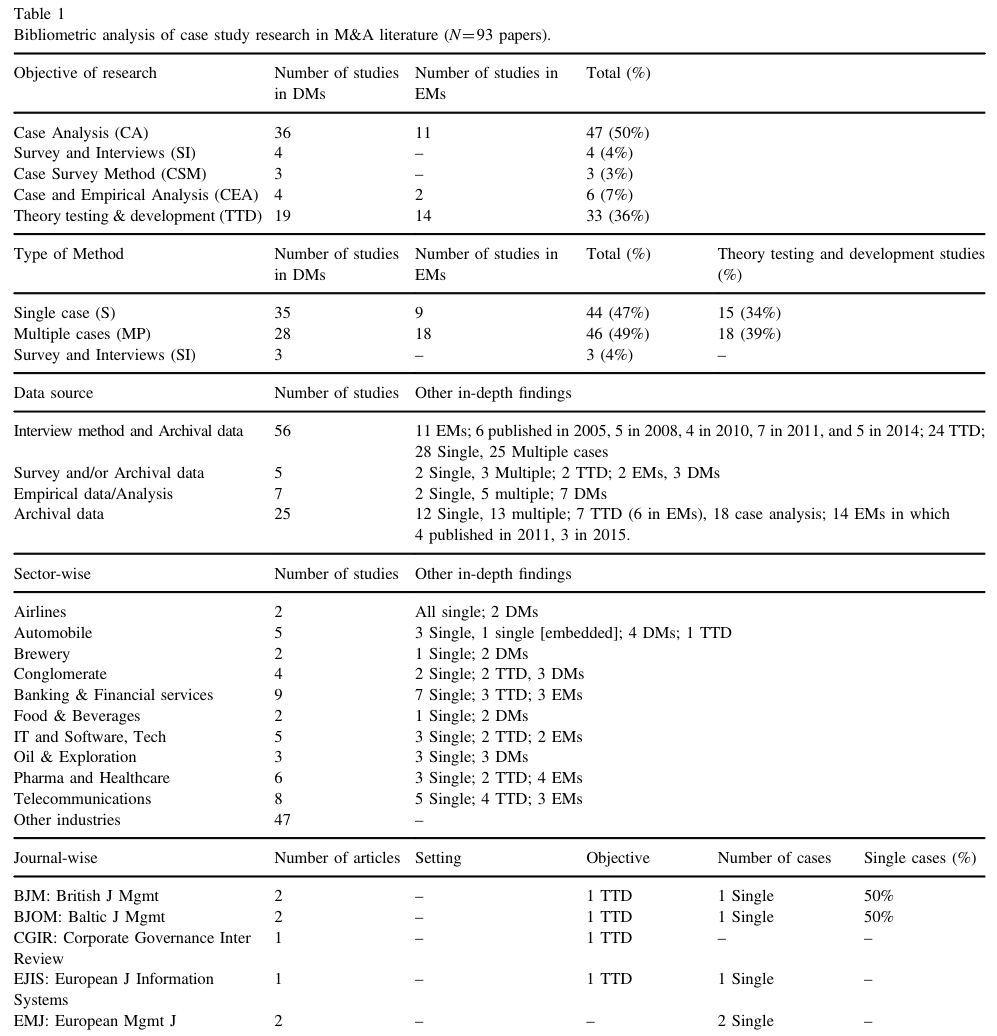
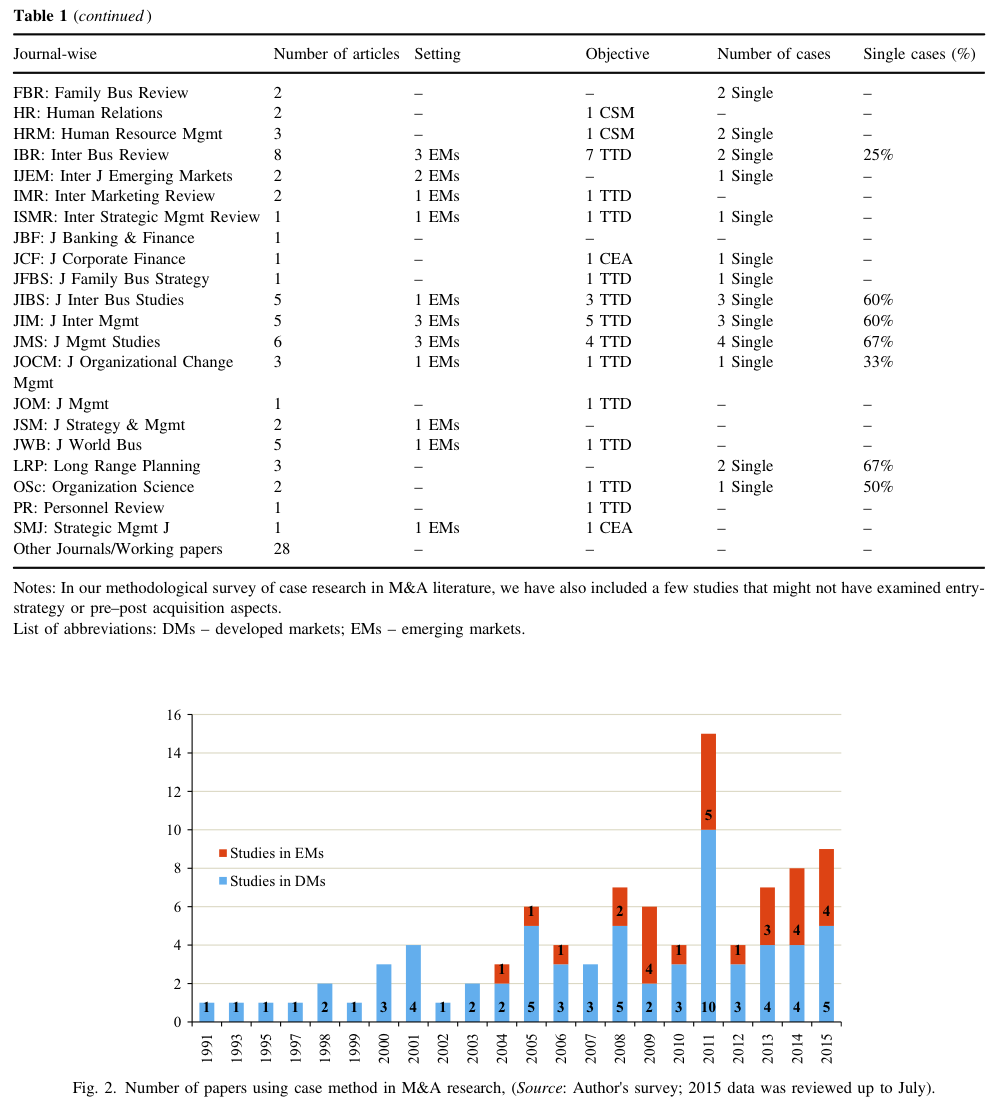

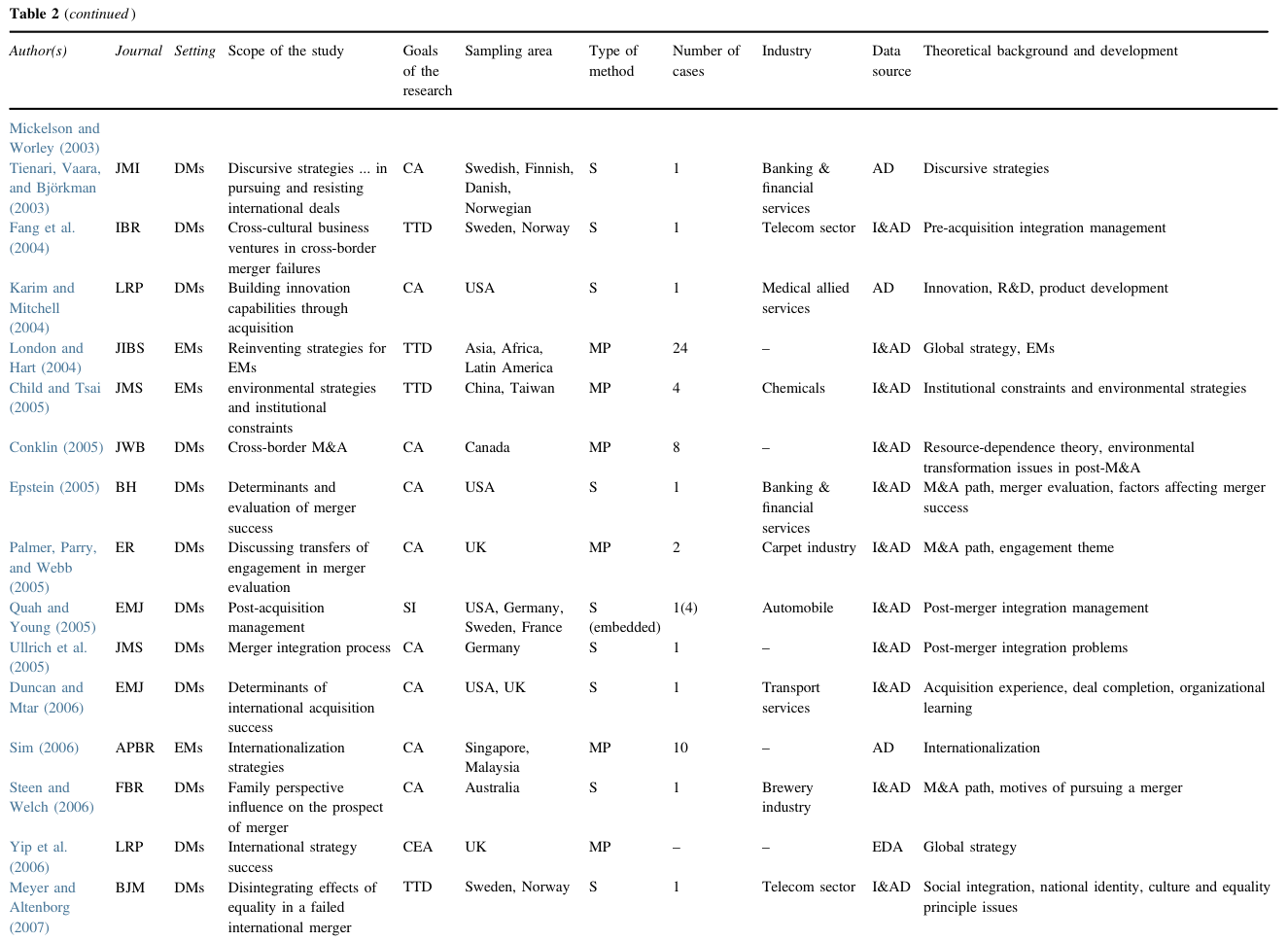
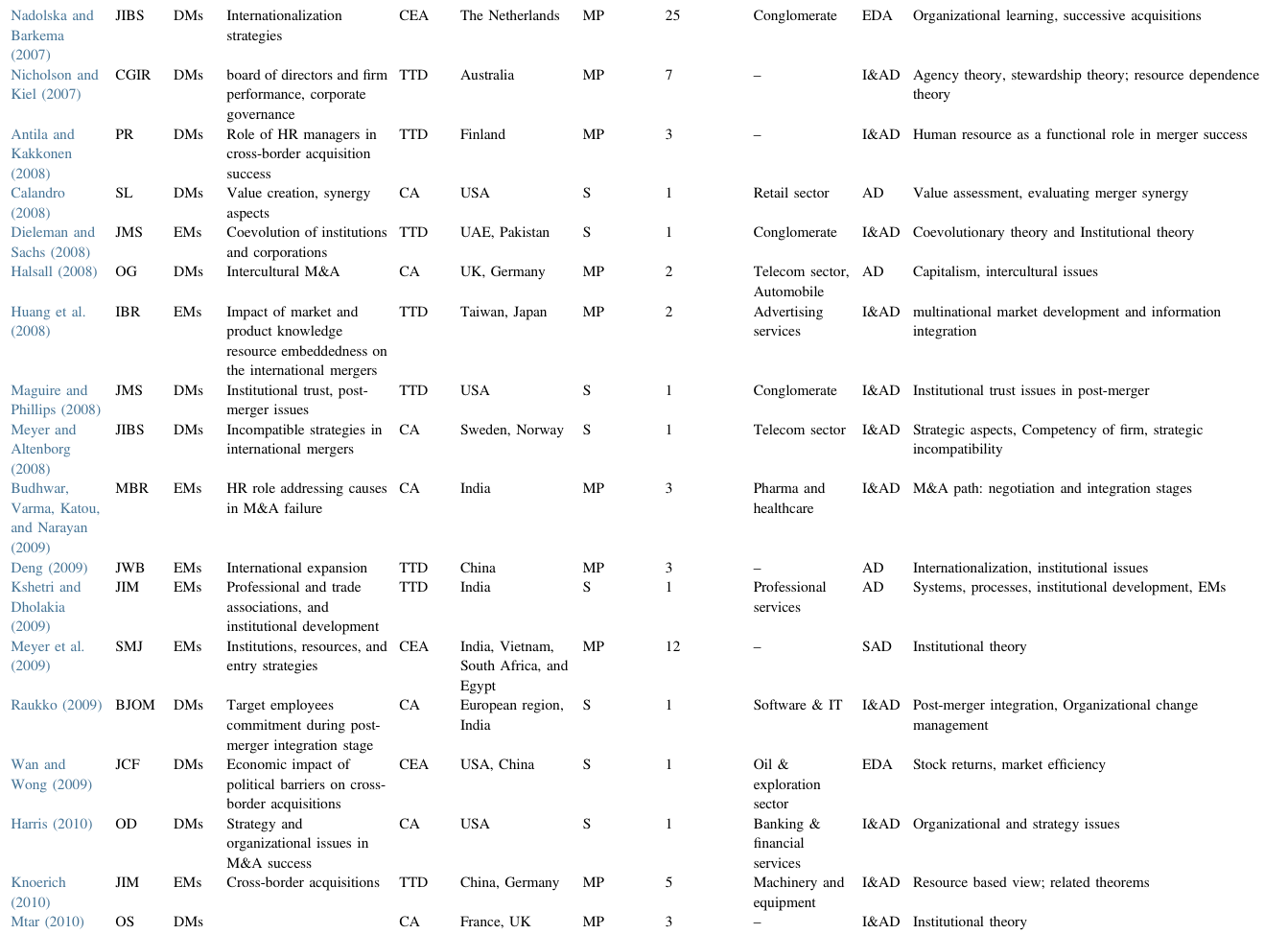
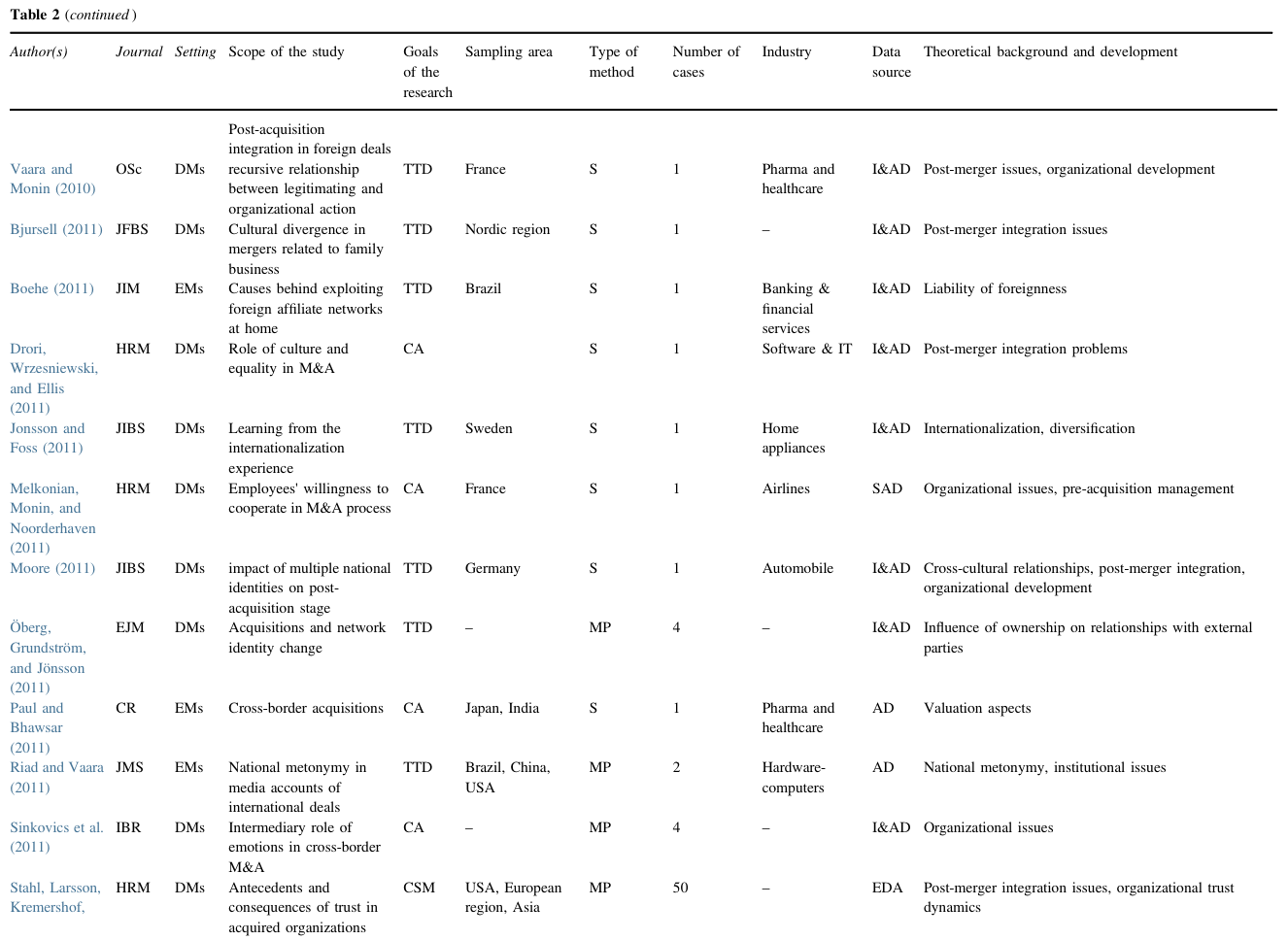
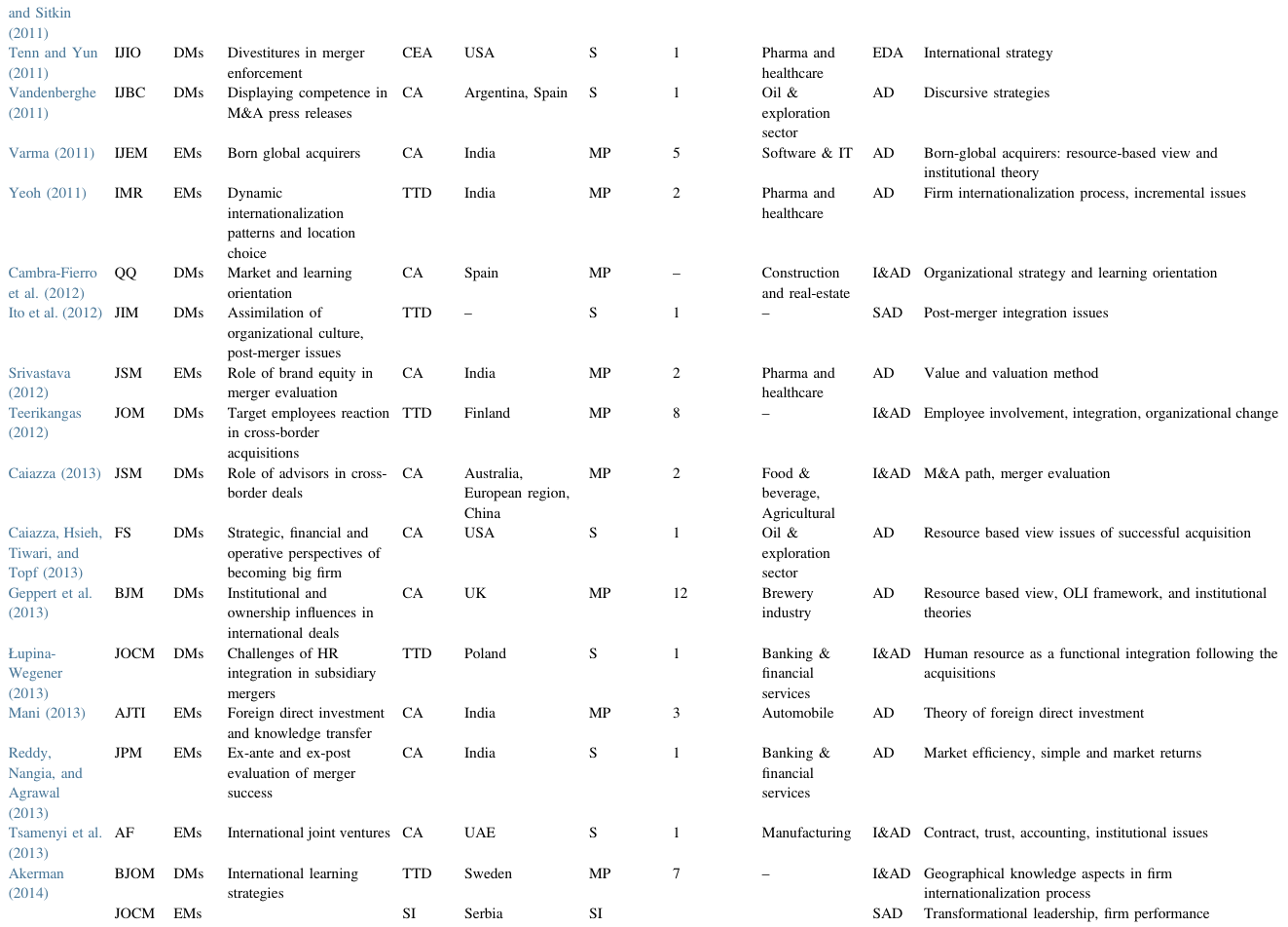

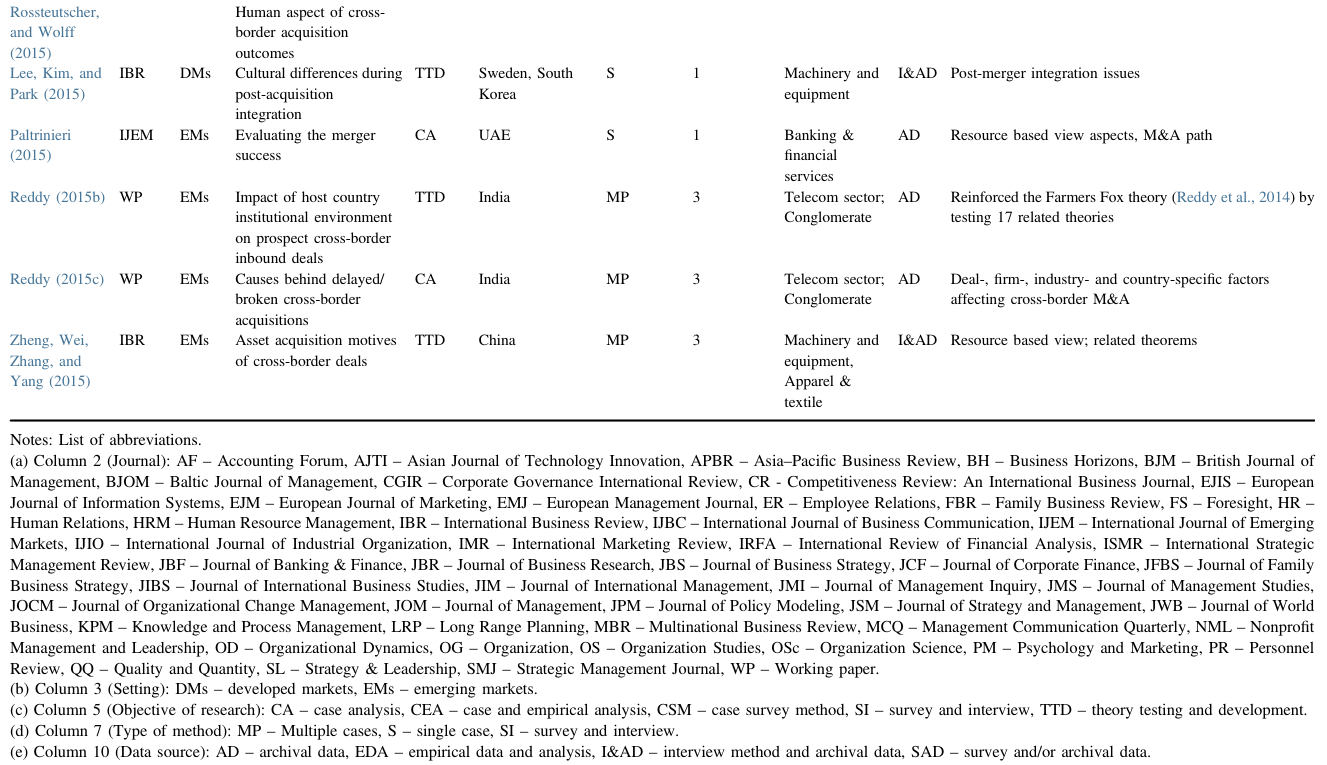
5. Research rigor: issues and opportunities
In this section, we specially emphasize on two aspects, namely how do we overcome problems relating to data collection, and how do we improve quality of study within the boundaries of case study method. Captivating this, we discuss the importance of triangulation, case study protocol, and quality and validity. In addition, one may also refer to the inputs suggested in previous conceptual notes and frameworks for reasons including the case selection biases and methodology rigor (Collinson & Rugman, 2010; Hoon, 2013; Reddy, 2015a), and using teaching cases for management research (Reddy & Agrawal, 2012). For instance, Ambrosini, Bowman, and Collier (2010) propose a set of guidelines for increasing the awareness on the use of teaching cases in management research of which they discuss teaching cases whether to-be used as an alternative to field research, and be used as secondary data in ‘when’ and ‘how’ taxonomies.
5.1. Triangulation
Triangulation is the critical, crucial and intelligence provider in case study research design. In our understanding, data triangulation supports the researcher in a range of research activities which include setting research objectives, research design and procedure, theory testing and importantly, theory development. It is defining a feature of case study approach (Ghauri & Firth, 2009). It helps case researchers to measure the quality of research output comprising trustworthiness of data, reliability of sources of data, and generalization of results to a larger population. It also enhances the construct validity (Yin, 2003), and the internal validity of the research (Ghauri, 2004; Pauwels & Matthyssens, 2004). Simply, it is data procurement from multiple sources and different kinds of data on the same phenomenon (Ghauri & Firth, 2009).
A qualitative researcher should seek reliability of data sources and trustworthiness of data and its meaning by using multiple methods and different data sources (Thyer, 2001). Eisenhardt (1989) defines that “triangulation is a multiple data collection methods which provides stronger substantiation of constructs and hypotheses” (p. 538). Eriksson and Kovalainen (2008) mention that triangulation is the appropriate method to merge qualitative and quantitative data sources particularly in case study research. Few authors describe that it is “a process by which a single phenomenon is examined with multiple observers, theories, methods, or data sources to determine the degree of convergence across components” (cf. Curry, Nembhard, & Bradley, 2009, p. 1449). The main advantages include, it can produce a more holistic and relative representation of the research objectives, which study from different angles (Ghauri, 2004). Further, it is useful to crosscheck the findings with respective data sources (Eriksson & Kovalainen, 2008). In others’ view, it has been used as a synonym for mixed methods but assumes a single reality, which is suitable within the realism paradigm and is not appropriate within constructivism or critical theory research (Sobh & Perry, 2006, p. 1202).
In the existing literature, we come across five kinds of triangulation. Yin (2003, pp. 97–99) proposed four types of which are data triangulation (using multiple sources of data), investigator triangulation (make use of more than one researcher), theory triangulation (to convey multiple theoretical frameworks for producing a mix of interpretations that used for theory testing), and methodological triangulation (blend of different methods or tools). However, it is important to mention, “a combination of interview, observation, and archival research can reduce possible distortions or misrepresentations” (Bitsch, 2005, p. 84). Pauwels and Matthyssens (2004) suggest fifth triangulation, that is, “analytical triangulation” (between-method triangulation, or within-method triangulation). Following this, we recall three kinds of triangulation, namely data triangulation, investigator triangulation and theory triangulation.
Data triangulation – is a mix of different data obtained from different sources. Therefore, the sources of data include primary and secondary data. We find a number of studies that applied CSR using primary data (interviews and questionnaire survey) in various institutional settings. Importantly, conducting case-based studies based on primary data is achievable in developed markets like US, UK, Sweden, France, Canada and other European economies. However, it is unlikely a practice especially in emerging markets (e.g., China, India, Africa) and is really a challenge to find key negotiators and convince them for the purpose of the study to secure their participation (e.g., Fang et al., 2004). In sum, interview or survey method is potential in post-merger integration (e.g., one or two cases) but not attainable in complex or litigated cross-border transactions, especially when the political intervention and regulatory (government) officials were propelled (Reddy et al., 2014).
On the other hand, archival data can be used independently as well, particularly when attempting to understand historical incidents, or economic or social systems […] archival data often take a supporting role to interviews and observation in management research (Shah & Corley, 2006, p. 1829). For example, “media texts are important and accessible representation of public discourse on M&A, which include direct opinions or statements by corporate executives and politicians or aim at influencing such constituents rhetorically. Further, media texts serve as a rich repository and allow a researcher to perform systematic case/cross-case analysis in the given setting”. In that case, M&A media accounts discuss events of interest, often citing ‘experts’ and the ‘public’ on a given topic … journalistic writing often involves metonymy which makes it a rich source of illustrations of the event (cf. Riad & Vaara, 2011, pp. 743–744). In essence, these texts tend to “contain a mix of both informative and persuasive elements …” (Vandenberghe, 2011).
Investigator triangulation – in Stake’s view (1995), using or appointing multiple researchers would be more helpful if the study represents interdisciplinary research, or based on different theoretical frameworks. Briefly, it is a right blend of principal investigator, research supervisors and committee, peers and anonymous referees.
Theory triangulation – Yin (2003) suggests it is an activity, which merges different interpretations derived from different theoretical backgrounds. Simply, we believe theory triangulation converts multidisciplinary into interdisciplinary. In Cheng, Henisz, Roth, and Swaminathan (2009), the authors cite that “any study or group of studies undertaken by scholars from two or more distinct scientific disciplines, based upon a conceptual model that integrates theoretical frameworks… not limited to any one field … throughout multiple phases of the research process”. Conversely, mergers/acquisitions is the lasting focused- area in management, which has been significantly investigated in novel subjects like economics, corporate finance, accounting, law, strategic management, IB, organization and human resources, marketing, information technology, hospitality, transportation, production, logistics and supply chain, among others (Haleblian et al., 2009; Shimizu et al., 2004). For instance, a cross-border acquisition mostly occurs in the form of FDI; therefore, it should investigate from different angles, particularly when dealing dispute, abuse or litigatation between two different nations. As such, case scholars should develop an interdisciplinary theoretical framework to improve the quality of research as well as generalize the findings to a bigger population. In sum, it allows a researcher to test different theories and develop a theory within the interdisciplinary setting.
5.2. Case study protocol
The purpose of the case study protocol (CSP) is to record a set of steps and research procedures that were adopted and followed in the case study research. Yin (1994) mentions that case researchers must develop a well-considered set of actions, rather than using ‘‘subjective’’ judgments (p. 41). It reports the summary of whole research project and ensures that work is valuable. Hence, scholars in various settings are using it differently, for instance, to ensure that primary data (e.g. interviews) is akin and the findings are therefore reliable (Carson et al., 2001). In Gibbert and Ruigrok (2010) view, CSP is a careful documentation, or an acknowledgment of case study research in which it enhances transparency and supports the trustworthiness of research work. We thereby understand that CSP plays a vital role in CSR design and helps the researcher to measure the quality of the study. In other words, it is similar to a bookkeeping concept in accounting jargon that records the events of research timely and carefully.
5.3. Quality and validity
Lastly, we explore the quality of the case study method in management research for various reasons. Similar to quantitative approach, case researchers must check the research rigor which refers to reliability, construct validity, internal validity and external validity (Cook & Campbell, 1976). Simply, validity in qualitative research indicates the truthfulness of findings (Thyer, 2001). Reliability emphasizes on the trustworthiness of data, which should be linked to the data triangulation and case study protocol. Construct validity suggests that the data collection method includes multiple sources such as interviews, survey and archival data. Internal validity underlines the accuracy of researcher observations and findings that should be linked among data, investigator and theory triangulation. External validity defines the transferability of results to a larger population. Regrettably, CSR has often criticized for various reasons, especially less rigor and biased results (Willis, 2007) due to its “qualitative sense” of findings (Shenkar, 2004). Yet, one should also remember that good social science research is problem driven and not methodology driven (Flyvbjerg, 2006, p. 242).
6. Conclusions
Qualitative researchers often use the case study method to test and advance the existing theory as well as to build new theory. Indeed, it is one of the legitimate tools of qualitative research to analyze critical organizational events in the given setting both to find a problem and to arrive at a conclusion. It suffers from different causes that are responsible for the quality and validity of the study. Research rigor not only depends upon the quality of the design and its implementation but also depends upon the researcher skills and experience, especially in qualitative case study approach. This study drawn attention at exploring the state of case study method in M&A related literature for various reasons, provided no previous study examined this. First, it presented bibliometric analysis and summary of previous studies using case method in M&A research. It highlighted that 93 journal articles use case method of which 66 (27) articles focus on developed (emerging) markets, single (multiple) case based studies are 44 (46) and remaining three adopt survey and interview method. Second, it offered a set of guidelines for improving the research rigor matters including triangulation, case study protocol, and quality and validity. On top of that, it also recalls four pillars of case method: sampling, sampling time, sampling area and selection criteria. Therefore, we conclude that application of case study method to M&A research in particular and to management research in general has embarked emerging markets settings for purposes including case analysis, testing extant theory and building new theory, and foresee increasing use of it among different management streams.
This review paper is limited to online journal publications and case study research. Hence, a survey of qualitative and quantitative methods in different growth strategies calls future research. Topical themes such as reasons behind unsuccessful acquisitions in local and international settings, post-merger integration management, cultural issues and challenges following foreign acquisitions, deal mechanism and role of managers, termination of managers in winning and losing deals, characteristics and motives of emerging market firms participating in overseas acquisitions, and employee training and organizational change performance’ offer unique setting as to adopt the case study method in future explorations.
Acknowledgments
Author wishes to thank Editor-in-Chief and anonymous referees of Future Business Journal for their thoughtful comments on previous version of this paper. All remaining errors are the responsibility of the author. The usual disclaimer applies.
TAGS:


Stay up to date with M&A news!
Subscribe to our newsletter


